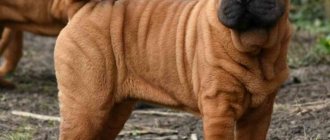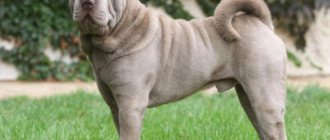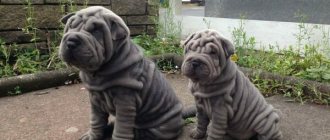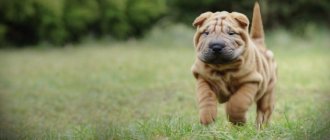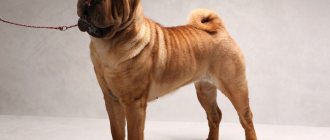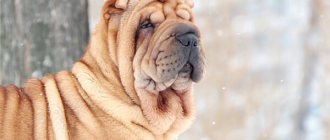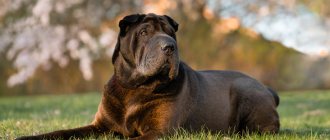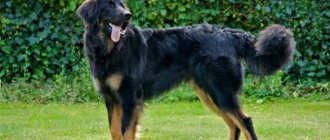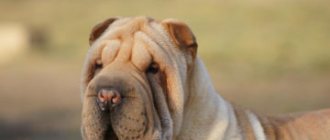Shar Peis are recognized by their folded skin, wide muzzle, and dark tongue. At first glance, he is a clumsy and clumsy good-natured man, but his character is not so simple. The breed has a fighting past; for a long time it was used for guarding and hunting. Not every person can cope with it. Therefore, before making such a spectacular friend, you should find out about its characteristics.
Brief history of origin
These dogs have lived in China for centuries in areas bordering the South China Sea. Most likely, the history of the breed began in the city of Daylak (Kwan Tung Province).
Scientists still don't know everything about Shar-Peis. It is believed that dogs of this type have existed for more than 3 thousand years. Previously, dogs took part in dog fights. The folds on the body had a practical function: the animals remained mobile and avoided serious injury, even if the enemy grabbed them by the body.
In the mid-40s of the twentieth century, Shar Peis were on the verge of extinction. In China, they began to be exterminated en masse - dogs were declared a symbol of belonging to the highest hierarchical class. However, some representatives of the breed were taken to America, where they continued to develop.
The breed was first registered by the ADBA (American Kennel Breeders Association) in 1971 under the name Chinese Fighting Dog. In 1976, she approved the first standard. In 1981, the breed was recognized by the FCI. Now the dogs are under her patronage.
Expert opinion
Leonid Rodin
Experienced dog breeder
Ask a Question
The thousand-year history of the Shar Pei is difficult to trace. And whether this dog existed in the form familiar to us in antediluvian times is also unknown. But the name of the man who saved the breed no more than half a century ago is known for certain. This is Matgo Lowe. The man was a Shar Pei breeder in Hong Kong, which was then an international British colony. Fearing that the territory would fall under Chinese jurisdiction, he published an open letter to dog lovers in Europe with the United States. On this occasion, Life magazine published his appeal in 1979, accompanied it with a large article and placed a photograph of a Shar Pei on the cover. This is how the mass acquaintance of the inhabitants of the Old and New Continents with the unique dog took place. The publication caused a lot of noise, and the demand for wrinkled Chinese puppies skyrocketed. Only once outside their limited Asian region did Shar Peis become recognizable and gained popularity, which has not declined to this day.
Description of pets
American Shar-Peis are slightly shorter than Chinese ones, have more skin folds on their faces, and have a more rounded head. The American Kennel Club adopted the breed standard in 1979, and the FCI approved it in 1999.
Breed standard:
- the head is large, the skull is round in shape, slightly flattened on top, the forehead is wide, sloping, the stop is moderately pronounced;
- the muzzle is wide, not narrowing towards the nose;
- the bridge of the nose is straight, a slight convexity at the base is acceptable, the lobe is wide, the nostrils are open;
- the lips are fleshy, the palate, gums and tongue are black-blue, with possible small pink spots on a dark background;
- jaws are strong, scissor bite;
- the eyes are small, oval, set deep in the folds of the skin, the iris is dark;
- the ears are small, triangular, fit tightly to the skull, set high and wide, the tips slightly rounded;
- the neck is medium, muscular, cone-shaped;
- the back is short, muscular, a deflection between the withers and a shortened loin is possible;
- the tail is of medium length, set high, thick at the base, tapering towards the end;
- The limbs are strong, not too long, located parallel.
The coat can be of 2 types: brush - soft hairs no more than 1 cm in length, and horse - hard hairs, reaching a length of 0.5-1 cm.
Interesting Facts
You can tell a lot of interesting things about this breed of dog:
- Scientists believe that Shar Peis, Tibetan Mastiffs and Chow Chows have common ancestors.
- Shar Pei is one of the oldest dog breeds of Chinese origin.
- In tombs dating back to the 3rd century BC. e., the remains of dogs resembling modern Shar-Peis were found.
- In ancient China, Shar-Peis were called "sky-licking dogs" because of their dark tongue. It was believed that with its help animals could scare away evil spirits.
- In 1978, Shar Peis were included in the Guinness Book of Records as the rarest breed in the world.
- The fur of these dogs often causes allergies. Therefore, before purchasing, it is advisable for all family members to interact with the puppy.
Description of genetic codes of standard colors
The color of a Shar Pei is determined by the presence of an allele in the animal. For example, Au contributes to the formation of a red tone, is present in sable color, the presence of recessive alleles occurs in diluts. Brown Shar-Peis have Bb. It is noteworthy that light, cream, isabella tones cannot be distinguished by phenotype. The color of future offspring can only be determined by experimental crossing. That is why many breeders, before entering the pet’s color into documents and issuing a passport, do special tests to determine the animal’s phenotype.
Reading: Liquid diarrhea in York: what to do and how to prevent the disease?
Shar Pei of standard or non-standard color is distinguished by playfulness, affection and affection for its owner. The choice of coat color is individual: some prefer a standard black tone, emphasizing the severity of the dog. But recently, a non-standard palette, color combination and the presence of spots have been of great interest to breeders.
Breed description, standards and appearance
The Shar Pei is an active dog with strong bones and an almost square body, having medium dimensions.
The head and front part of the body are covered with characteristic folds. It was they who made the breed recognizable throughout the world.
Ideal animal sizes:
- height 44-51 cm (boys are larger than girls);
- The weight of an adult dog is not specified in the standard (an animal can weigh from 18 to 35 kg).
Official description of the Shar Pei (breed standard No. 309):
- The head is large. The folds that turn into a dewlap on the neck visually make it even larger.
- The skull is smooth and wide.
- The stop is moderately pronounced. Divides the dog's head exactly in half.
- The nose is large, with developed nostrils. Dark pigmentation is encouraged, but a lobe colored in the color of the animal's fur is not considered a fault.
- The muzzle is wide, without a hint of narrowing towards the nose (experts call it “hippopotamian”) - this is a characteristic feature of the Shar Pei breed. A small bump at the base of the nose is not penalized.
- It is desirable that the gums, tongue and palate be bluish-black. Pinkish spots on the tongue are acceptable, but a solid pink color is a disqualifying fault. Shar Peis of diluted colors (without black pigment) have a lilac tongue.
- The jaws are powerful and set in a perfect scissor bite. The lower lip should not be overly fleshy, otherwise it will interfere with the correct bite.
- The eyes are almond-shaped. The look is serious and gloomy. The pigmentation of the iris is predominantly dark. Lightening is acceptable in animals of diluted colors. Wrinkles and fur on the face should not irritate the eyes or otherwise affect their health.
- The Shar Pei's ears are small, thick, with rounded tips, and shaped like an isosceles triangle. Located high on the head. The tips hang down towards the eyes. Shar Peis with erect ears are disqualified.
- The neck is medium size, powerful, sits firmly on the shoulders. The folds on it should not be too abundant.
- The topline is smoothly curved: it descends behind the withers and rises to the croup. The back is strong, the loin is short. Folds on the body of adult Shar-Peis are not acceptable. The exception is the area near the withers and at the base of the tail. Young dogs may have a little more wrinkles, but with age they should smooth out.
- The chest is voluminous, descending to the elbows. The belly is only slightly tucked in.
- The tail is thick and sits very high. Twisted into a regular ring or curved over the back. Dogs with missing or too short tails will be disqualified.
- The limbs are smooth, parallel, and muscular. The paws are compact, the dewclaws are removed.
Shar Peis run with ease and balance, pushing strongly with their hind legs and swinging their front legs well.
The typical gait is trot. As the dog gains speed, the limbs move closer to the center line. Stilted and constrained movements are extremely undesirable.
Types of Shar Pei
During the selection process, Shar Peis were divided into several species:
- The Chinese Shar Pei is a classic representative of the breed, a descendant of fighting dogs. It is its description that is presented in the ICF standard.
- American Shar Pei - bred on the basis of dogs brought from China in the 20th century. These animals are taller and longer-legged, with fewer wrinkles on the face. The characteristic color is black.
- Shar Pei Bear is a shaggy dog. It appeared due to the influx of Chow Chow blood during the work to restore the livestock, which was carried out in the second half of the 20th century. The fluffy Shar Pei is common in Russia, the USA and Europe.
- English Shar Pei (also called European) - bred in Europe. Outwardly it resembles the Chinese variety, but looks more stretched out and has a calm and docile character. The protective instinct is weakly expressed.
- Mini Shar-Pei, or Mini-Pei, is a dog whose height is less than acceptable. Such a puppy can be born from purebred parents. Many people liked the dwarf Shar-Pei, so separate clubs appeared to breed it.
Important. There are no other varieties like the Belgian Shar Pei. To develop certain qualities in animals, the breed is often crossed with shepherd dogs, pit bulls, Labradors and Staffordshire terriers.
The modern breed standard does not recognize any types or varieties of these dogs. Animals that do not correspond to the official description cannot participate in international exhibitions.
Color and coat type
Shar Pei is a smooth-haired breed. Her body is covered with straight and coarse hair. Depending on the length of the guard hair, dogs are divided into 2 groups:
- Horse - about 1 cm. The structure of the wool resembles bristles.
- Brush – length reaches 2.5 cm. The hairs feel a little softer.
The fur stands straight up, only on the limbs it is slightly adjacent to the body. Shar Peis do not have an undercoat, which is why they do not tolerate low temperatures well.
The breed standard allows any solid colors with the exception of white. The tail and the area underneath may be slightly lighter, while the line along the spine and ears may be darker.
Shar-Peis of speckled, black and tan, black, brindle and spotted colors, as well as albino dogs, are subject to disqualification. Long-haired animals (hair longer than 2.5 cm), which are also called the bear type, are considered a waste, but have their fans.
The types of coats of Shar-Peis can be divided into the following categories:
- Horse hair (horse).
- Brush-shaped (brush).
- "Bear fur."
The breed standard allows for many color variations. The most common colors are black, cream, fawn, mahogany (reddish), blue, isabella, and sable. In addition to the main color, the animals have black pigment spots similar to a mask and a belt on the back.
A color with no black spots is allowed.
- Cream.
- Apricot.
- Chocolate.
- Lilac color.
There are also dogs of non-standard colors:
- Spotted.
- Black-and-brown (black-brown).
In the first option, the main color is white, on which specks are placed. With the saddle color, the back is black and the tan marks are light in color.
Character and behavior
The purpose of the Shar Pei dog breed is as a hunting and guard dog. These animals are distinguished by their balance and independence, they are vigilant and wary of strangers.
Shar Peis become very attached to their owner and become jealous if a person pays attention to someone else. But the dog will not happily run to meet the owner from work. The dog will calmly wait until the owner himself pays attention to him.
There are several negative traits in the character of the Shar Pei dog breed:
- These dogs tend to be dominant. They must be led by a strong and confident person.
- Shar Peis are stubborn. It is very difficult to force them to do something if they don’t want to.
- The breed does not get along well with other pets. Shar Pei considers dogs as rivals, and rodents and birds as potential prey. The exception is cats if the dog has been familiar with them since childhood.
But negative qualities do not reduce the popularity of the Shar Pei breed, the characteristics of which largely depend on upbringing. If you train a dog correctly, it will grow into a loyal and obedient friend.
Breed and children
The Shar Pei dog is not very suitable for families who are planning to have a baby. It will be difficult for an adult dog to get used to a new family member. In addition, the pet does not tolerate disrespectful treatment, and perceives sudden movements as a threat.
But the dog will probably get along with a teenager who knows the rules of behavior with animals.
Education and training
These pet hippos are independent and stubborn. During the training process, you will urgently need patience and firmness, since teaching commands actually becomes a clash of wills between the owner and the dog. If your pet does not respond to certain demands, the problem is not at all a lack of mutual understanding - he is not lacking in intelligence, but the desire to dominate a person leads to disobedience.
It is important from the first days of a puppy’s arrival in a new family to demonstrate your authority without aggression, clearly defining the boundaries of what is permitted. The main mistake at this stage may be indulging the desires of a “cute baby” that looks so much like a soft toy. Restoring discipline after you show weakness will be very, very difficult!
In addition to following standard commands, a mandatory part of learning “good manners” should be the ability to behave in the presence of strangers and other pets. Any unmotivated manifestations of aggression are unacceptable here, although you cannot demand from a Shar Pei unusual delight at the sight of any guest. The ideal option would be a restrained reaction.
How to choose the right puppy?
To buy Shar Pei puppies, you should choose a reliable nursery. Frequently sold by hand are not purebred or sick animals that have little in common with real representatives of this breed of dog.
A small Shar Pei should not be angry or cowardly. In normal condition, puppies are active and playful, do not have an unpleasant odor, damage to the skin or mucous membranes. You should carefully examine the dog to identify defects in the exterior.
For your information. Boys are often bred for a show career, girls - for breeding and as a companion.
At birth, puppies of this breed do not have folds, but by 1.5 months they are completely covered with them. As they grow older, the wrinkles smooth out - the dog seems to “catch up” with the size of its own skin. To find out whether the baby will meet the standard, you should meet his parents.
A purebred puppy must have documents: a veterinary passport and birth certificate.
Diseases and life expectancy
Shar Peis have a strong immune system. They rarely have health problems and are mainly associated with poor care. The most common disease in this breed is food allergies. It can be identified by the following symptoms:
- redness of the sclera;
- tearfulness;
- copious nasal discharge;
- skin eczema;
- swelling of the muzzle;
- heat;
- severe hair loss.
If hygiene rules are not followed, inflammatory processes in the ears can develop, since they are poorly ventilated.
Among other diseases characteristic of Shar Pei, it is worth noting:
- entropion of the eyelid;
- pathologies of the thyroid gland;
- skin diseases caused by mites;
- tumor formations of internal organs.
A specific disease to consider is Shar Pei fever. It is typical for representatives of this breed only and is manifested by a sharp jump in body temperature, tremors, and swelling of the joints. If this happens, you need to give the dog an injection of Analgin, Diphenhydramine and No-shpa.
Another condition that occurs exclusively in these dogs is mucinosis. In Shar Pei it is the norm, while in other breeds it is a pathology. According to test results, the content of mucin in Shar Pei plasma is 5 times higher than in other dogs. A gelatinous substance is deposited in the skin. Mucinosis can be vesicular and subcutaneous. In the latter case, mucin accumulates in the folds, in the first, small blisters appear on the epidermis. They do not pose a danger to the dog's health, but they are very itchy. The condition can be alleviated with corticosteroid medications. If you provide your Shar Pei with proper care, his health will not cause serious trouble to the owner. The lifespan of these dogs is 8-10 years.
Caring for puppies
A newborn Shar Pei feeds exclusively on mother's milk - it provides the puppy with all the necessary substances. At the 4th week, complementary foods are introduced:
- goat or cow's milk;
- vegetable puree;
- small pieces of meat.
The puppy is fed 5 times a day in small portions.
As they grow older, fermented milk products and cereals are introduced into the diet. At 3 months, a puppy of this breed can already eat sea fish and offal. The number of meals is reduced to 4 times.
As a percentage, about 50% of the food should be meat, 30% should be cereals, 10% each should be vegetables and cottage cheese with kefir. However, as puppies begin to change their teeth, the need for calcium increases, so the proportion of fermented milk products is slightly increased. In agreement with the veterinarian, the Shar Pei is given calcium supplements.
From six months onwards, it is enough to feed the dog 3 times a day. But the portions should be voluminous - the Shar Pei puppy is still actively growing and gaining muscle mass. The daily amount of food is determined at the rate of 7-8% of the dog’s weight.
By the age of one year, the frequency of feeding the animal is reduced to twice a day.
Color variations
The new color registry adopted in 2005 included red, fawn, black , cream, sable and blue . As well as delute red, cream, apricot and chocolate shades.
In addition, all solid coat colors except white are considered acceptable.
Delute-colored Shar-Peis have a smoky or chocolate mask on their faces, while Isabella Delutes have a lilac mask.
Care and maintenance of an adult dog
Shar Peis are designed for apartment living. These animals do not bark over trifles and behave calmly and reservedly. The dog will happily rest while the owner is busy - destructive activities are not interesting for him.
In summer, the Shar Pei can live outside in an enclosure or kennel. But to prevent the dog from getting bored, you will have to spend more time playing together.
Shar Pei cannot be kept outside in winter. Short hair does not retain heat well - the animal will quickly become hypothermic and get sick. Therefore, during the winter months, the dog should be allowed indoors.
You can learn more about caring for your pet in the article “All about keeping Shar-Peis.”
The right diet
High-quality ready-made dog food from the brands Acana, Orijen, Go!, Now! etc. The main thing is that they are at least premium class and contain up to 12% fat and up to 23% protein.
With natural feeding, the basis of the diet of dogs of this breed is lean meat (rabbit, turkey, lamb) and high-quality offal (lung, kidneys, heart, liver, tripe).
Not all animals digest beef well, so it should be given with caution.
The adult Shar Pei menu also includes:
- rice and buckwheat porridges;
- vegetables and fruits;
- low-fat fermented milk products;
- chicken eggs and sea fish (2 times a week).
Any salty, fatty, fried, smoked food, food containing dyes and preservatives is contraindicated for animals.
This dog breed is prone to food allergies. If a negative reaction occurs, the product that provoked it is immediately excluded from the diet, and the pet is put on a rice diet. When the animal’s condition returns to normal, the usual food is returned to the menu.
Nutrition
The lion's share of breeders of this breed believes that the optimal feeding regimen for Shar Pei is twice a day. Therefore, when choosing a diet for a four-legged friend and when creating a menu, owners should remember that it is better to give preference to dietary products. The dog is prone to obesity and easily gains excess weight. The prevention of obesity is the most effective physical activity.
In some countries, the Shar Pei's blue tongue is believed to ward off evil spirits.
By the way, the dog itself is quite selective and picky about food. Therefore, more than one week may pass before her taste preferences and the owner’s finances coincide. An adult Shar Pei should receive a sufficient amount of fresh meat.
At least 35% of the diet consists of fruits and vegetables, the same amount - cereals and meat products. The remaining percentage comes from dairy products, which includes everything except the milk itself. It is forbidden to feed a Shar Pei with butter, sweets, give it salty, fatty and smoked foods, avoid caviar and sausage, as well as pearl barley and wheat groats.
Vaccinations and susceptibility to disease
Shar Pei puppies are vaccinated with complex vaccines against the most dangerous diseases. The first vaccination is given at 8-9 weeks, the second - after 14-21 days. At about 6 months, when the change of teeth ends, they are vaccinated against rabies. Adult dogs are vaccinated every year.
Shar Peis are quite sickly dogs. They are susceptible to:
- dysplasia of the elbow and hip joints (partial or complete destruction of the joints);
- dislocations of the kneecap (displacement of the kneecap in the femur block);
- osteochondrosis (cartilage degeneration);
- Shar Pei fever (swelling of the hock joint);
- hypothyroidism (lack of thyroid hormones);
- seborrhea (disruption of the formation of horny substance in the cells of the epidermis);
- demodicosis (skin disease caused by mites);
- pyoderma (infectious skin disease);
- cutaneous mucinosis (excessive deposition of mucin in the skin);
- otitis (inflammation of the ear canal);
- Gastric volvulus (twisting of the stomach around the esophagus);
- entropion (incorrect fit of the edge of the upper or lower eyelid to the cornea of the eyeball).
On average, representatives of the breed live 10-12 years.
What do Shar Peis get sick with?
Despite good health, representatives of the Shar Pei breed are prone to certain diseases, namely:
- Pathology of the eyes and ears.
- Skin diseases (dermatitis).
- Thyroid gland dysfunction.
- Tumors of internal organs.
To protect your dog from serious illnesses, when the first symptoms appear (an unpleasant putrid odor from the skin, poor appetite or refusal to eat, decreased physical activity), contact your veterinarian.
This breed has a fairly strong innate immune system and good health, but the pet needs to be vaccinated regularly. By providing proper living conditions in an apartment or private house, you guarantee a long life for your four-legged friend. The average lifespan of the Shar Pei breed is 12 years.
Shar Pei mating and pregnancy
It is recommended to breed Shar Peis no earlier than 1.5-2 years. Dogs are in heat for 18-21 days, but the best time for fertilization is from 10 to 15 days. At this time, when you press on the croup, the girl moves her tail to the side, and the discharge from the loop becomes almost transparent.
But due to individual circumstances, the timing varies. Some representatives of the Shar Pei breed may become pregnant a little earlier or later.
The dogs are first introduced on neutral territory, after which the girl is brought to the boy. In a familiar environment, the male feels more confident and acts more actively.
After ejaculation, Shar Peis remain “locked” for 10 minutes to several hours. To increase the likelihood of conception, re-mating is carried out after two days.
The first signs of pregnancy become noticeable around the 4th week. The belly becomes slightly rounded, and the expectant mother becomes calmer and more affectionate. In total, the dog bears puppies for about 9 weeks. If the babies are not born on the 63rd day after the control mating, you should contact a veterinarian.
Shar Pei labor begins with pushing. Then the amniotic fluid leaves. Puppies are born at intervals of 15-20 minutes. The dog itself gnaws the umbilical cord and intensively licks the baby so that it takes its first breath.
Important. It is worth agreeing in advance with the veterinarian about a possible visit if complications arise during childbirth.
Métis
To obtain mixed breeds, two different breeds of dogs are crossed. Shar Peis have many similar crosses.
Most mestizos are born very smart and easy to train.
Labrador mix
This kind of crossing is at the beginning of the journey and is quite rare. Externally, the dog resembles a Labrador, only with folds. Especially on the face. The color will be solid, the color may be different. The size turns out to be something average. Less Labrador, but more Shar Pei.
This mixed breed is resistant to genetic diseases. By nature, he is more likely to be a companion who gives love than a guard.
With a shepherd
This is a more popular crossbreed. With its body structure, short hair, and wide muzzle, the dog resembles a Chinese ancestor. Height is about fifty-two centimeters. But the color, like that of a shepherd, has a zonal pattern. Also, a shepherd dog can cause damage to its sickle-shaped tail and erect ears.
The dog is very smart and easy to train. But she is quite willful, so she needs a trainer with a strong character.
Most often, the Shar Pei is crossed with the German Shepherd.
Caucasian, Central Asian and Eastern European breeds are not in great demand due to possible genetic problems.
With a pit bull
It is impossible to say for sure which parent the puppy will resemble. Genes are unpredictable. A mixed breed can grow tall, with a pitbull face, or vice versa, shorter than a Shar Pei. The coat color is varied: black, brindle, sand. But most dogs have a black mask on their face.
Their body is muscular and may have folds.
From an early age, such mestizos have a wayward character and will listen to few people.
To prevent them from showing aggression, they need a strict person who will educate them.
With Stafford
This type of crossing is not very common due to genes. In childhood, the mixed breed looks like a Shar Pei due to the presence of folds. As an adult, he becomes similar to the Staffordshire Terrier. The height is about fifty centimeters, like the Shar Pei. Weight about 30 kg. In this way he is like a second parent.
The character is quite problematic, because at the beginning the animal will be affectionate and friendly, and then will begin to show aggression
. An experienced dog handler can help deal with this problem.
With a mongrel
It is impossible to predict what a mongrel cross will look like.
In most cases, dogs grow to be medium in size with large muzzles. There will be folds. The color can be varied, for example, sand color. The coat is short and smooth.
Character is friendly and playful. Such dogs are smart, quick-witted, and calm. They are very loyal to their owner and quickly learn the rules of behavior.
Shar Pei is a breed that is in demand. They are calm and intelligent. There are several varieties from which you can choose a puppy to suit your taste. But in the absence of such opportunities, you can always take a mestizo. They are no worse than purebred dogs if they are given enough attention and raised correctly.
How much does a Shar Pei puppy cost?
In Russia, the cost of a puppy of this breed varies quite widely. It depends on the exterior, pedigree and reputation of the nursery.
Approximate prices:
- pet class – 15 thousand rubles;
- breed class – 25-30 thousand rubles;
- show class - from 50 thousand rubles.
In Moscow, purebred Shar Pei puppies can be bought in nurseries:
- "ShatShun" https://www.sharpei-land.com;
- “Black Siskin” https://www.shar-pei-puppy.ru;
- "Ingram Ray" https://chinese-sharpei.ru.
Where to buy and price
You need to buy a puppy from trusted nurseries (BSS, Zolotaya Rybka, Gemmaris Gem) or from breeders who value their reputation. They must provide all necessary documents and veterinary certificates. It is better to buy a baby in the house where the bitch lives. There you can get acquainted with the conditions of keeping the dogs, ask the breeder about the rules of feeding and caring for the baby.
The price of a Shar Pei from show-champion parents starts at $500. A puppy without a pedigree can be purchased from an ad on the Internet for $100, but such a pet may end up with serious health problems, which will cause the owner a lot of problems instead of joy. When you decide to get a Shar Pei, you should evaluate your capabilities (including financial ones). This is a complex breed that requires skills in raising and training dogs.
Pros and cons of the breed
The characteristics of the Shar Pei breed are quite ambiguous - these dogs have both pros and cons.
| pros | Minuses |
| Original appearance | Tendency to dominate |
| Balance and devotion | Poor health |
| Feels good in the apartment | Stubbornness |
| Excellent security qualities | Jealousy |
| Developed intelligence | Doesn't get along well with other pets |
| Easy care |
Shar Pei is a dog with an exotic appearance and a difficult character, an excellent companion for calm and strong-willed people. If you treat your pet as an equal, he will repay you with love and boundless devotion.
Breed traits
Breed traits (on a 5-point scale)
| Shar Pei | |||
| Activity | in the house | 2.6 | |
| on the street | 3.3 | ||
| Obedience | training | 3.3 | |
| strangers | 4.4 | ||
| Domination | in family | 2.5 | |
| over dogs | 3.8 | ||
| Defending your territory | from people | 3.5 | |
| from dogs | 3.9 | ||
| Sociability | in family | 4.4 | |
| with strangers | 2.9 | ||
| with dogs | 2.7 | ||
| Concentration | in family | 1.7 | |
| in front of strangers | 3.2 | ||
| with dogs | 3.1 | ||
| Aggressiveness | in family | 1.8 | |
| to strangers | 3.2 | ||
| to the dogs | 3.3 | ||
| to cats | 3.4 | ||
| Family behavior | calmness | 3.8 | |
| demand for affection | 3.7 | ||
| excitability | 3.7 | ||
| playfulness | 3.7 | ||
| excessive barking | 1.8 | ||
| behavioral breakdowns | 1.9 | ||
| Tolerance for children | up to 4 years | 3.6 | |
| over 4 years old | 3.7 | ||
| Institutional use | watchman | 4.6 | |
| bodyguard | 3.7 | ||
This breed is often compared to the following dog breeds: English Bulldog, Labrador Retriever, Cane Corso, German Shepherd, American Staffordshire Terrier.
Interesting photos of Shar Pei dogs, by which they are easy to recognize:
Shar Pei
Shar Pei
How and what to feed
For normal growth and development, black-colored puppies and adult dogs can be kept on natural feeding, ready-made food or a mixed type of food.
Many breeders recommend feeding their pets dry food. The food consists of properly selected calories, vitamins and minerals, and helps to grind teeth. It is convenient to serve it in portions corresponding to the weight of the dog.
Natural feeding includes the following components:
- beef or veal meat;
- cottage cheese, kefir;
- vegetables fruits;
- cereals (rice, buckwheat);
- sea fish;
- dietary supplements, vitamins.
Remember, you should feed your dog at certain hours, at the same time. Don't forget to change the water and keep the bowls clean. Avoid giving bones to avoid injury to the esophagus.
Keep an eye on your pet who is prone to obesity. Feed dry food specifically formulated for these types of dogs.
Dimensions, weight and other distinctive features
Blue Shar-Peis are compact, robust dogs with a square body. Males are larger than females. A characteristic feature of the breed is a huge number of folds. There are especially many of them on the face.
- height : about 50 centimeters. Bitch height: about 45 centimeters.
- weight : from 23 to 25 kilograms. Bitch weight: from 20 to 22 kilograms.
- Lifespan : from 8 to 12 years.
- Head : wide, flat, with a strong muzzle without narrowing. Many folds give the dog a gloomy and serious expression.
- Ears : small, thick, triangular in shape, curved forward.
- Eyes : almond-shaped, medium size, wide range of brown.
- Jaws : Strong and strong, with large teeth. The bite is scissor-shaped. Puppies may have an underbite. The lips, tongue and gums are highly pigmented, blue-black, even lavender in color.
- Neck : With well developed muscles and dewlap, there may be some excess skin but no folds from ears to shoulders.
- Chest : resembles an oval, quite deep and voluminous.
- Back : strong, developed, wide.
- Croup : slightly sloping, not short.
- Limbs : with well-developed muscles, powerful, parallel. The front legs are straight. Hind - with pronounced angles of the hock joints.
- Tail : curved in a ring - double, single, incomplete. It is allowed if the tail is thrown over the back, but does not touch it.
- Coat : hard, straight, prickly. The length varies - from not reaching 1 centimeter to 2.5 centimeters.
- Color : various shades of gray-blue - from light, silver, to the color of wet asphalt. Other shades may also appear: pink, brown.
Variety of Shar Pei colors
Representatives of Shar Peis can have a whole range of different colors:
- black - most often, shades of black with an admixture or tint of another color, pure black is very rare;
- golden, sandy - this color is considered the original color characteristic of the Shar Peis of Ancient China;
- red – a wide range of shades: from light orange to mahogany;
- cream - from soft beige to light caramel;
- sable – wool coated with shades of gray;
- chocolate - from baked milk to dark brown;
- blue - from pale blue to wet asphalt.
The breed standard also allows complex, combined colors consisting of several shades.
Characteristics of the dog
Among the main criteria that interest potential owners, the following numbers are displayed on a 10-point scale:
| Characteristic | Grade |
| Difficulty of training | 5 |
| Intelligence | 5 |
| Tendency to shed | 5 |
| Dimensions | 5 |
| Agility | 5 |
| Sentry abilities | 7 |
| Security features | 7 |
| Popularity | 7 |
| Attitude towards children | 10 |
